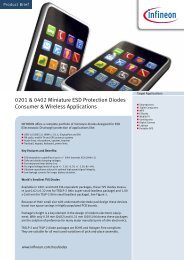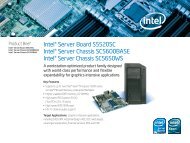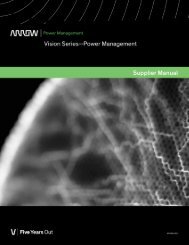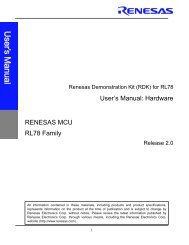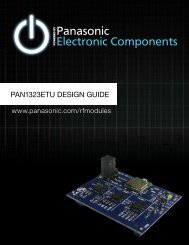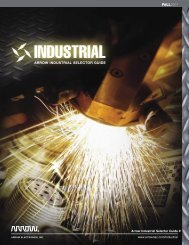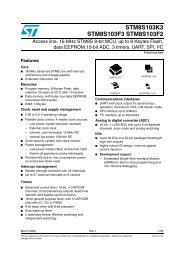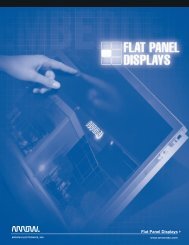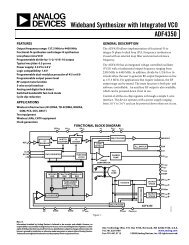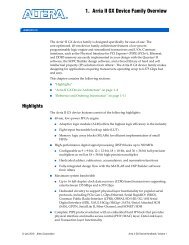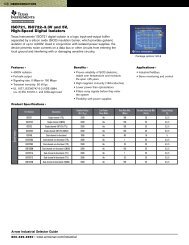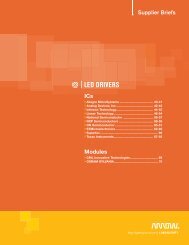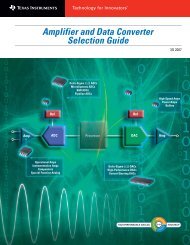Medical Applications Guide (Rev. B - Mouser Electronics
Medical Applications Guide (Rev. B - Mouser Electronics
Medical Applications Guide (Rev. B - Mouser Electronics
You also want an ePaper? Increase the reach of your titles
YUMPU automatically turns print PDFs into web optimized ePapers that Google loves.
6➔Consumer and Portable <strong>Medical</strong> DevicesDigital ThermometersDigital ThermometersDigital thermometers are quickly replacing traditional mercury thermometers.Digital thermometers are fast, accurate and effective. Withnewer technologies, different types of digital fever thermometers maybe classified on the basis of the location where they are used such asoral, rectal, underarm, ear, etc. The ear thermometer measures theinfrared heat of the eardrum, which reflects the temperature of thehypothalamus — the temperature-controlling system of the brain.Infrared sensors are used in ear thermometers for measurement,while thermopiles or thermistors may be used in other types.Depending on cost considerations, different types of digital thermometersare available. High-end thermometers have a number ofthermopiles or thermistors, whose resistance changes with temperature.The change in resistance is measured as a change in voltage. Thisanalog voltage is converted digitally by an analog-to-digital converter(ADC). The speed and resolution of this ADC depends on the accuracyand time at which information is needed. However, if an ADC moduleis not available, then it is possible to digitize the analog signal by usinga comparator and a timer, using slope A/D conversion. This method isgenerally used in low-cost versions of digital thermometers. The singleslope conversion is a simple method for measuring temperature.Capacitance, supply voltage and frequency changes caused by agingor temperature drift can be compensated by using a ratio metricmeasurement principle. Detailed information about the slope conversionprinciple can be found in the application note “Implementing anUltra-Low-Power Thermostat with Slope A/D Conversion” (SLAA129).The block diagrams at right show both the low-end general-purposeand high-end versions of digital thermometers. Typical ADC resolutionused in general-purpose digital thermometers may be 12-bit and abovedepending on the accuracy level required. A good reference for theADC is also required for better accuracy. A microcontroller may beused for control purposes. Low-cost solutions employ a low-cost,low-power microcontroller like the MSP430, which has the integratedcomparator and timer to digitize the analog signal using the slopeA/D conversion technique.Other additional features like high temperature alarm, beep aftermeasurement, auto shut-off and data log of previous temperaturesmay also be featured in thermometers. Most thermometers haveeasy-to-read displays, usually a LCD display and low-battery indicator.Other peripherals include digital I/Os and LCD drivers.TThermopileor ThermistorOp AmpMSP430 MicrocontrollerDigital I/OsComparatorTimerMSP430 MicrocontrollerADC(>12 Bits)ReferenceLCD Control(LCD Driveror I 2 C)Digital I/OsA general block diagram of a low-cost digital thermometer.LCD Control(LCD Driveror I 2 C)MemoryDigital I/OsMemoryKeypadA general block diagram of a digital thermometer with high accuracy.LCDKeypadLCD<strong>Medical</strong> <strong>Applications</strong> <strong>Guide</strong> Texas Instruments 2Q 2007



